The IPS all-ceramic system from Ivoclar Vivadent offers more than 20 years of proven experience to you and your dentists. IPS
e.max® & IPS Empress® CAD is a lithium disilicate ceramic that provides optimum esthetics and strength. IPS e.max &
IPS Empress CAD can be stained or layered to achieve virtually perfect contacts and occlusion. The absence of shrinkage
optimizes fit, making it suitable for implants and anterior or posterior crowns. Conventionally bond or cement with resin ionomers. IPS Empress® Esthetic leucite-reinforced restorations offer lifelike esthetics. Choose between traditional build-up, pressable
crowns and CAD/CAM fabricated restorations. IPS Empress is indicated for anterior single-unit crowns, inlays, onlays and
veneers. Choose IPS Empress CAD Multi for anterior full crowns, three-quarter crowns, inlays, onlays and veneers. IPS Empress restorations must be bonded.
IPS e.max & IPS Empress and IPS Empress are registered trademarks of Ivoclar Vivadent.
IPS e.max & IPS Empress at 360 MPa has three times the strength (flexural) of original IPS Empress.
The CTE (coefficient of thermal expansion) of IPS e.max is 10.2 (100-400°C).
IPS e.max & IPS Empress has opacity of about 40 percent (or 60 percent translucency or show-through: regular Empress has an opacity of about 30 percent.
If adjustment is required on the ceramic, ALWAYS CEMENT OR BOND INTO PLACE BEFORE PROCEEDING, then use a fine diamond with water to keep the crown cool. To contour the crown, polish with a porcelain polishing wheel ( Brassler, Shofu and Vident) and diamond polishing paste.
Caution: Do NOT attempt to fire porcelain. IPS e.max ceramic requires specific stains and glaze, as well as precisely calibrated ovens at specific temperatures and vacuum settings. For best results, return crown for re-glaze firing to lab.
INDICATIONS / CONTRAINDICATIONS
IPS e.max CAD is indicated for full anterior or posterior crowns. IPS e.max press is indicated for full anterior or posterior crowns and three-unit bridges having only one pontic with the second bicuspid as the most distal abutment. Veneers can also be indicated and are recommended when combining with adjacent IPS e.max crowns or bridges, provided ample reduction is achieved. Otherwise, original IPS Empress or IPS e.max CAD would be indicated for veneers, inlays and onlays.
IPS e.max should not be used on patients with malfunctional occlusion such as bruxers or clenchers. IPS e.max should not be used as abutments for cast partials. IPS e.max should not be used in situations when preparation requirements cannot be achieved. IPS e.max is not indicated for Maryland-type bridges.
IPS Empress is recommended for anterior single crowns, inlays, onlays and veneers.
PREPARATION
Anterior full-coverage crowns require a Chamfer with 1.5-2.0mm facial reduction, 1 - 1.5 mm lingual contact clearance, 1.5 - 2 mm incisal reduction 1 - 1.5 mm reduction at the gingival margin with rounded internal line angles; or a Shoulder with 1 mm lingual reduction, 2 mm incisal reduction, 1.5 mm labial reduction, 1 mm 360 degree rounded shoulder.
Posterior full-coverage crowns require a Chamfer margin with 1.5 - 2 mm occlusal reduction, 1.5 mm buccal and lingual reduction with rounded internal line angles; or a Shoulder with 1.5 - 2 mm occlusal reduction, 1.5 mm buccal and lingual reduction and 1 - 1.5 mm gingival margin reduction with rounded internal line angles.
Inlays and Onlays require 1.5 - 2 mm isthmus width, 1 - 1.5 mm wide gingival floor with rounded internal line angles and butt joint margins.
Veneers require a uniform preparation and lingual reduction to increase strength. A medium-grit round-ended diamond is used to join the depth cut grooves to establish a uniform preparation and porcelain thickness of at least 1 mm. The diamond is angled to eliminate undercuts and establish a butt joint on the lingual aspect of the preparation. The incisal edge should be rounded to eliminate sharp line angles.
Chamfer Margins - Correct preparation of the chamfer margins interproximally allows the appropriate bulk of porcelain.
A Slice Preparation - This technique enables the ceramist to close the space and avoid unnatural lingual contours.
CEMENTATION
For greatest strength, and where preparation allows for dry field (supra-gingiva margins), it is recommended to use Adhesive bonding, such as VarioLink II or similar dual cure materials (Insure, Nexus, Choice and Lute-It).
For areas subgingival, or when a dry field cannot be achieved, Ivoclar recommends a Hybrid Glass Ionomer cement system with less than 0.5% expansion. (NOTE: Resin-reinforced glass ionomers such as Advance & Vitremer are not indicated for any all-ceramic restoration.)
Any type of Adhesive bonding/Dual Cure materials such as:
Variolink/Dual Cement (Ivoclar)
Choice (Bisco)
Porcelite (Kerr)
Insure (Cosmedent)
WORKING TIME
3 Days In-lab
We guarantee a 3-days in-lab turnaround on the products, so you can expect to receive your shipment in 8 days including
shipping.




